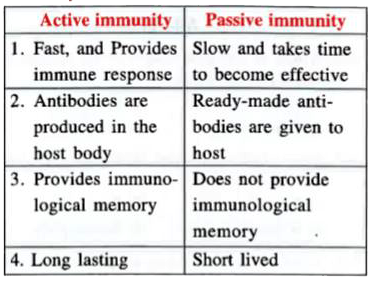Which of the following is passive immunisation ?
Injecting inactivated pathogens
Injecting antigenic preparation
Injecting preformed antibodies
Injecting weakened pathogens
The correct Answer is:C
To determine which of the given options is an example of passive immunization, we can analyze each option based on the definitions and characteristics of passive and active immunity.
1. Understand Passive Immunization:
- Passive immunization involves the transfer of preformed antibodies to an individual. This provides immediate but temporary protection against pathogens.
2. Analyze the Options:
- Option 1: Injecting inactivated pathogens:
- This is a form of vaccination that stimulates the immune system to produce its own antibodies. This is an example of active immunization.
- Option 2: Injecting antigenic preparation:
- Similar to inactivated pathogens, this involves introducing antigens to stimulate the immune response, which is also a form of active immunization.
- Option 3: Injecting preformed antibodies:
- This directly provides antibodies to the individual, which is characteristic of passive immunization. It does not require the immune system to produce its own antibodies.
- Option 4: Injecting weakened pathogens:
- This is another form of vaccination that stimulates the immune system to respond and is thus an example of active immunization.
3. Conclusion:
- After analyzing all options, we find that injecting preformed antibodies (Option 3) is the only example of passive immunization.
Final Answer:
Injecting preformed antibodies is the correct answer for passive immunization.
---
- Passive immunization involves the transfer of preformed antibodies to an individual. This provides immediate but temporary protection against pathogens.
- Option 1: Injecting inactivated pathogens:
- This is a form of vaccination that stimulates the immune system to produce its own antibodies. This is an example of active immunization.
- Option 2: Injecting antigenic preparation:
- Similar to inactivated pathogens, this involves introducing antigens to stimulate the immune response, which is also a form of active immunization.
- Option 3: Injecting preformed antibodies:
- This directly provides antibodies to the individual, which is characteristic of passive immunization. It does not require the immune system to produce its own antibodies.
- Option 4: Injecting weakened pathogens:
- This is another form of vaccination that stimulates the immune system to respond and is thus an example of active immunization.
- After analyzing all options, we find that injecting preformed antibodies (Option 3) is the only example of passive immunization.
Injecting preformed antibodies is the correct answer for passive immunization.
Topper's Solved these Questions
- HUMAN HEALTH DISEASEBOOK - AAKASH SERIESCHAPTER - HUMAN HEALTH DISEASEEXERCISE - EXERCISE - I(VACCINES)
8 Videos
- HUMAN HEALTH DISEASEBOOK - AAKASH SERIESCHAPTER - HUMAN HEALTH DISEASEEXERCISE - EXERCISE - I(ALLERGIES)
11 Videos
- HUMAN HEALTH DISEASEBOOK - AAKASH SERIESCHAPTER - HUMAN HEALTH DISEASEEXERCISE - EXERCISE - I(ANTIBODY)
6 Videos
- HISTOLOGY AND ANATOMY OF FLOWERING PLANTSBOOK - AAKASH SERIESCHAPTER - HISTOLOGY AND ANATOMY OF FLOWERING PLANTSEXERCISE - EXERCISE - III (PREVIOUS AIPMT/NEET QUESTIONS)
24 Videos
- MICROBES IN HUMAN WELFARE BOOK - AAKASH SERIESCHAPTER - MICROBES IN HUMAN WELFARE EXERCISE - EXERCISE-III (Previous AIPMT/NEET Questions)
25 Videos
Similar Questions
Knowledge Check
Which of the following statements are correct?
(i). Reabsorption of water occurs passively in the initial segment of nephron.
(ii). Nitrogenous wastes are absorbed by passive transport.
(iii). Conditional reabsorption of Na+ and water takes palce in DCT.
(iv). DCT reabsorbs HCO−3
(v). DCT is capable of selective secretion of H+,K+ and NH3 to maintain pH and Na+−K+ balance in blood.
(vi). Substance like glucose, amino acids, Na+, etc,. it the filtrate are reabsorbed actively.Aa)(i) and (ii)Bb) (ii) and (iii)Cc) (iv) and (v)Dd) all of these
What is immunisation?
View SolutionUse of vaccines and immunisation programmes have controlled which of the following infectious diseases ?
View SolutionWhich one of the following is an example of polygenic inheritance ?
View SolutionWhich of the following is correct regarding mineral ions absorption in plants?
(a) Most of the mineral ions are absorbed passively and actively absorbed
(b) Most of the mineral ions are absorbed passively
(c) All the mineral ions are actively absorbed
(d) All the mineral ions are passively absorbed
View SolutionWhich of the following substances are absorbed by passive transport ?
View SolutionWhich of the following is not a correct difference between active immunity and passive immunity

View SolutionWhich of the following statement correctly describes the respiratory tract ?
I the right lung is larger than the left
II expiration is predominantly a passive phenomenon
III air enters the lungs because of created negative pressure
View Solution